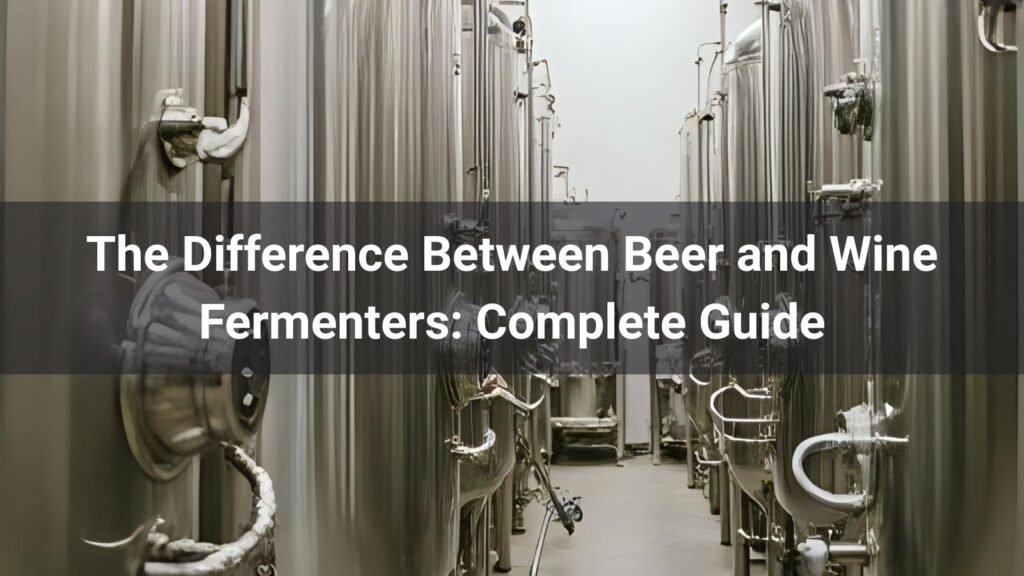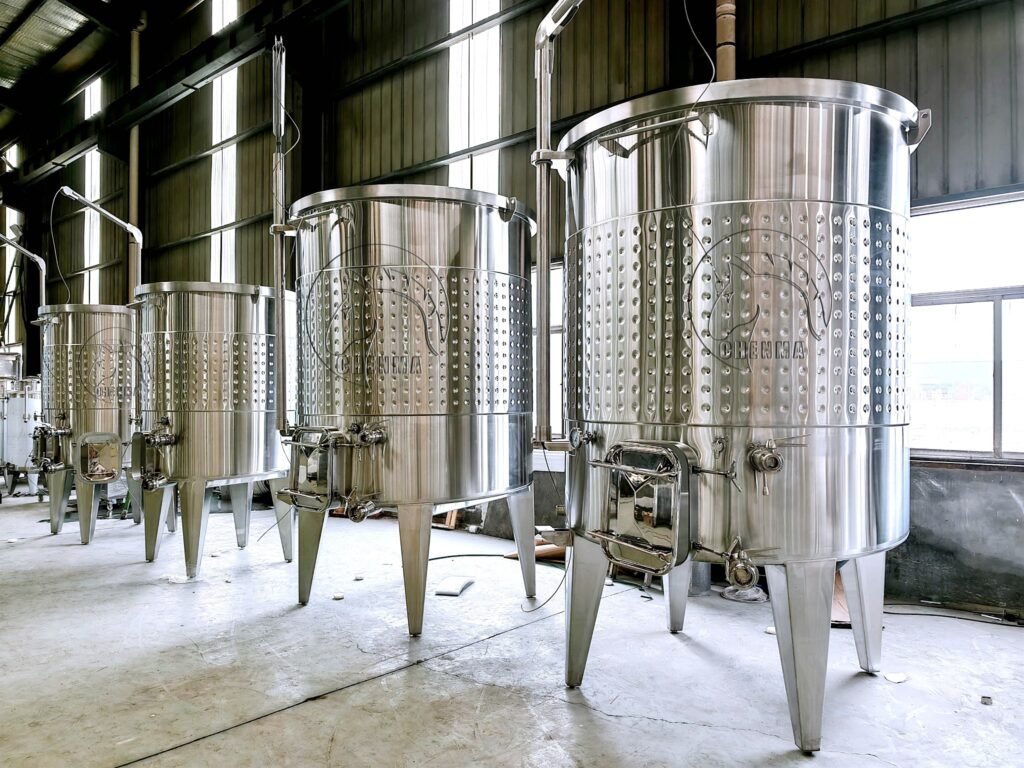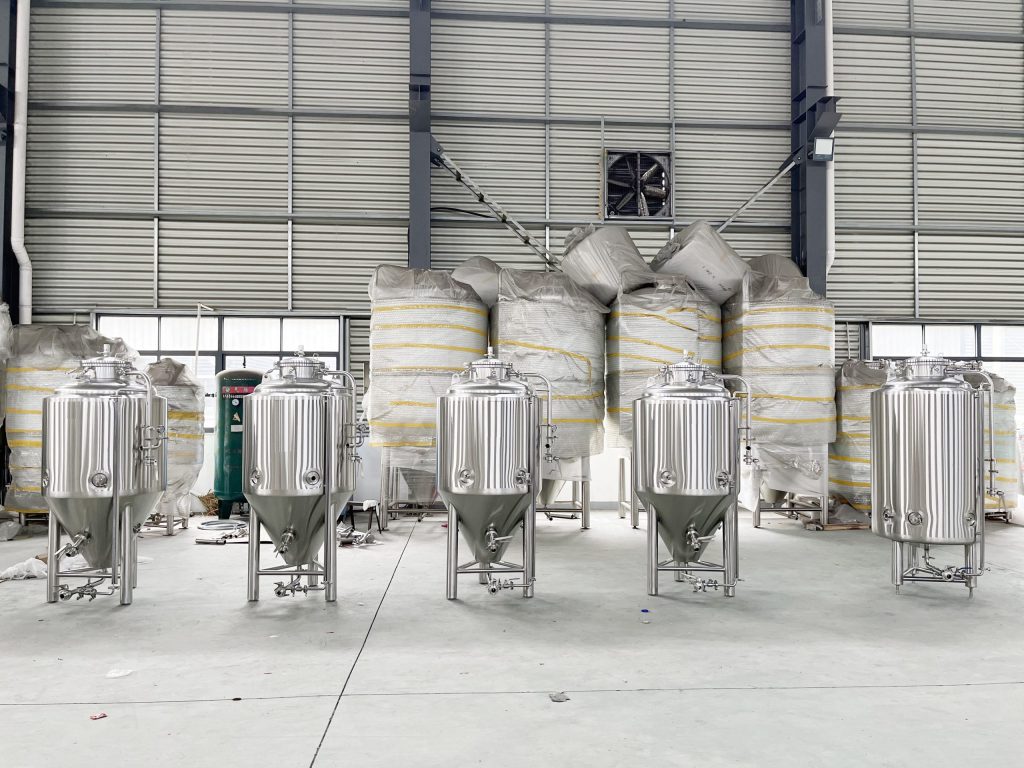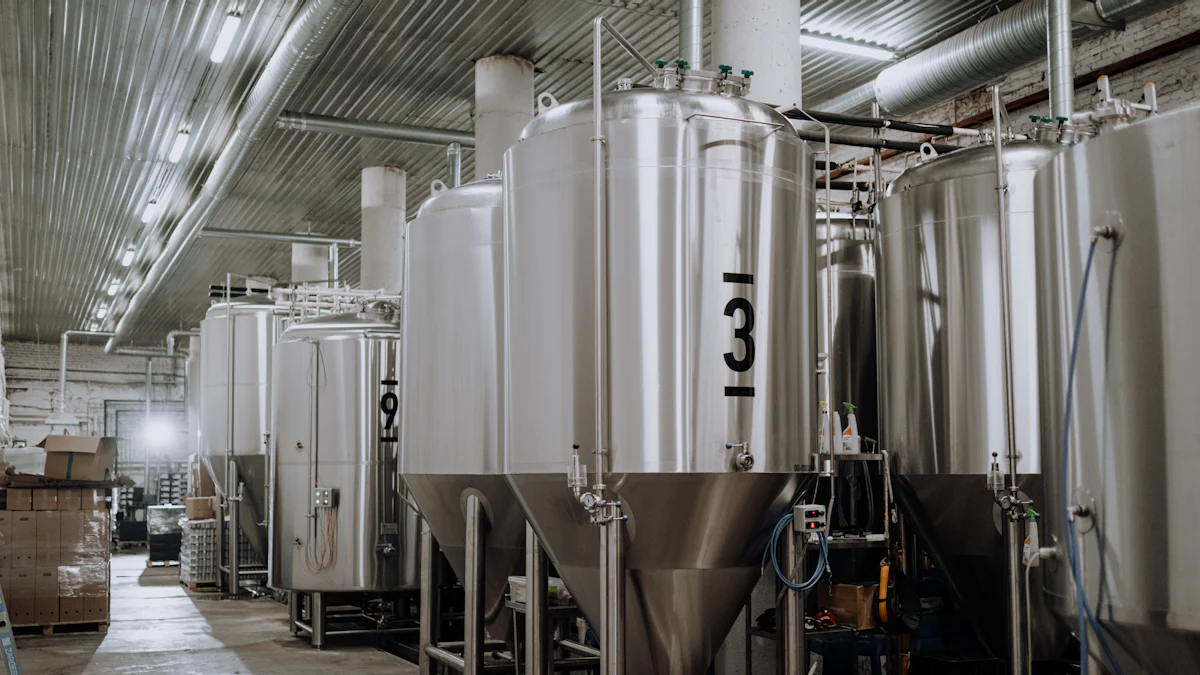
Table of Contents
Understanding the fundamental differences between beer and wine fermentation tanks is crucial for beverage producers looking to optimize their production processes. While both serve the essential function of converting sugars into alcohol, beer and wine fermenters vary significantly in design, operation, and specifications. This comprehensive guide explores the key distinctions in tank construction, fermentation processes, temperature requirements, and design considerations that make each fermenter type uniquely suited to its specific beverage production needs.
Beer Fermentation Tank
Beer fermentation tanks, commonly known as fermenters or FVs (fermentation vessels), are specifically engineered to handle the unique requirements of beer production. These vessels typically feature conical bottom designs that facilitate yeast collection and removal, making them essential for maintaining beer clarity and quality.
Modern beer fermenters are predominantly constructed from stainless steel, offering superior durability, easy cleaning, and excellent temperature control capabilities. Top beer fermentation tanks for breweries incorporate advanced features like pressure rating capabilities, sample ports, and integrated cooling systems.
The typical beer fermenter operates under controlled pressure conditions, often ranging from 0.5 to 2.0 bar, depending on the beer style and fermentation stage. This pressure capability allows brewers to conduct natural carbonation during fermentation and enables the production of various beer styles with different carbonation levels.
| Beer Fermenter Features | Specification | Purpose |
|---|---|---|
| Conical Bottom | 60° – 90° angle | Yeast harvesting and sediment removal |
| Pressure Rating | 0.5 – 3.0 bar | Natural carbonation and process control |
| Cooling Jacket | Glycol or direct expansion | Precise temperature control |
| Sample Valve | Stainless steel butterfly valve | Quality monitoring during fermentation |
Wine Fermentation Tank

Wine fermentation tanks differ significantly from beer fermenters in both design philosophy and operational requirements. Wine fermentation vessels prioritize gentle handling of the product and often feature open-top designs for traditional fermentation methods, particularly for red wines where cap management is essential.
Wine fermentation tanks are available in various configurations, including variable capacity tanks with floating lids, traditional open-top fermenters, and closed systems for white wine production. The choice depends on the wine style, production volume, and winemaking philosophy.
Unlike beer fermenters, wine tanks often operate at atmospheric pressure during primary fermentation. However, some modern wine fermentation systems incorporate pressure capabilities for specific techniques like carbonic maceration or controlled fermentation environments.
Stainless steel versus oak wine fermentation tanks presents an ongoing debate in winemaking, with each material offering distinct advantages. Stainless steel provides precise temperature control and easy sanitation, while oak contributes flavor complexity and traditional character.
| Wine Tank Type | Best For | Key Features |
|---|---|---|
| Open-Top Fermenters | Red wine fermentation | Cap management, punch-down access |
| Variable Capacity Tanks | Small batch production | Floating lid, minimal oxygen exposure |
| Closed Fermenters | White wine, controlled atmospheres | Inert gas capability, temperature control |
Fermentation Microorganisms Are Different
The fundamental difference between beer and wine fermentation lies in the microorganisms employed and their specific operational requirements. These biological differences directly influence fermenter design and operational parameters.
Beer fermentation relies primarily on specific strains of Saccharomyces cerevisiae (ale yeast) or Saccharomyces pastorianus (lager yeast). Ale yeasts are top-fermenting organisms that work optimally at warmer temperatures (15-24°C), while lager yeasts are bottom-fermenting and require cooler conditions (7-15°C).
Wine fermentation utilizes various yeast strains, including wild yeasts naturally present on grape skins and cultured Saccharomyces cerevisiae strains selected for specific wine styles. Wine yeasts typically tolerate higher alcohol concentrations than beer yeasts, often continuing fermentation until alcohol levels reach 12-15% or higher.
The yeast behavior differences necessitate distinct fermenter designs. Beer and wine fermentation tank differences include considerations for yeast harvesting, flocculation characteristics, and byproduct management.
| Fermentation Aspect | Beer | Wine |
|---|---|---|
| Primary Yeast | S. cerevisiae / S. pastorianus | S. cerevisiae / Wild yeasts |
| Alcohol Tolerance | 8-12% ABV typical | 12-16% ABV common |
| Fermentation Behavior | Top or bottom fermenting | Distributed throughout must |
| Secondary Organisms | Generally avoided | Malolactic bacteria common |
The Brewing Process Is Different
The distinct brewing and winemaking processes require fundamentally different fermenter designs and operational capabilities. Understanding these process differences is essential for selecting appropriate fermentation equipment.
Making Wine
Wine production begins with grape crushing and must preparation. Red wine fermentation typically involves extended skin contact during fermentation, requiring open-top fermenters or tanks with wide access ports for cap management. The fermentation process often includes punch-downs, pump-overs, or other extraction techniques that influence tank design.
Red wine fermentation tanks impact flavor and quality through their design features that facilitate proper extraction and temperature control. White wine production, conversely, typically involves immediate pressing and fermentation in closed systems to minimize oxygen exposure.
Wine fermentation often extends for weeks or months, including primary alcoholic fermentation and potential secondary malolactic fermentation. This extended timeline requires robust temperature control systems and materials that won’t impart off-flavors over long contact periods.
Brew Beer
Beer brewing follows a more controlled and predictable process timeline. After mashing and lautering, the wort is boiled with hops before cooling and yeast pitching. Beer fermentation typically completes within 7-21 days, depending on style and conditions.
The beer brewing process emphasizes yeast health management and controlled fermentation conditions. Brewing tank fermenter designs with conical bottoms facilitate yeast harvesting and beer clarification, essential aspects of consistent beer production.
Beer fermentation generates significant CO2, requiring proper venting and pressure management systems. Many brewers capture and reuse this CO2 for carbonation and packaging operations, influencing fermenter design considerations.
Different Temperatures Are Required
Temperature control represents one of the most critical differences between beer and wine fermentation systems. Each beverage type requires specific temperature ranges for optimal fermentation performance and product quality.
Beer fermentation temperatures vary significantly by style. Lager production requires precise low-temperature control, often maintaining temperatures between 7-13°C throughout fermentation. Ale fermentation occurs at moderate temperatures (15-24°C), while specialty styles may require even higher temperatures.
Wine fermentation temperature requirements depend on grape variety, desired style, and winemaker preferences. Red wines typically ferment at 20-30°C to facilitate color and tannin extraction, while white wines prefer cooler temperatures (10-18°C) to preserve delicate aromatics.
| Product Type | Temperature Range | Control Requirements |
|---|---|---|
| Lager Beer | 7-13°C | Precise, stable control |
| Ale Beer | 15-24°C | Controlled ramping |
| White Wine | 10-18°C | Gentle, consistent cooling |
| Red Wine | 20-30°C | Moderate control, allow peaks |
The temperature control requirements influence cooling system design and capacity. Maintaining stainless steel fermentation tanks includes regular inspection and maintenance of cooling systems to ensure consistent temperature performance.
Fermentation Tanks Are Designed
The fundamental design differences between beer and wine fermentation tanks reflect their distinct operational requirements, product characteristics, and production philosophies.
Beer fermenter design prioritizes controlled environments, efficient yeast management, and consistent product quality. Key design elements include conical bottoms for yeast harvesting, pressure-rated construction for natural carbonation, integrated cooling systems, and comprehensive monitoring capabilities.
Stainless steel wine fermenter tanks offer numerous benefits including durability, temperature control, and easy cleaning. However, wine tank design also accommodates traditional winemaking practices and varies significantly based on wine style requirements.
Wine fermentation tanks often feature wider aspect ratios to facilitate cap management in red wine production. Variable capacity wine tanks provide flexibility for small-batch production and minimize oxygen exposure during fermentation and aging.
| Design Feature | Beer Fermenters | Wine Fermenters |
|---|---|---|
| Bottom Design | Conical (60-90°) | Flat or shallow cone |
| Top Configuration | Closed with PRV | Open or variable capacity |
| Aspect Ratio | Tall and narrow | Wide and low to moderate |
| Access Ports | Sample and CIP | Large manways, punch-down access |
| Pressure Rating | 1-3 bar typical | Atmospheric to 1 bar |
Modern fermenter design incorporates advanced materials and manufacturing techniques. Stainless steel wine tanks offer fermentation advantages through superior temperature control, easy sanitization, and long service life.
The choice between different tank designs depends on production goals, budget considerations, and operational preferences. Choosing the right stainless steel wine tank requires careful evaluation of these factors alongside specific winemaking requirements.
Professional Fermentation Tank Solutions
Shandong Chenma Machinery Co., Ltd. specializes in designing and manufacturing both beer and wine fermentation systems tailored to specific production requirements. Our comprehensive solutions include:
- Custom tank design and engineering
- Advanced temperature control systems
- Complete process automation
- Installation and commissioning services
- Ongoing technical support and maintenance
Contact Information:
- Website: sdchenma.com
- WhatsApp: +86 180 6342 1809
- Email: admin@sdchenma.com
- Address: Pingyuan County Economic Development Zone, Dezhou City, Shandong Province
With over 200 experienced professionals and state-of-the-art manufacturing facilities, we deliver reliable fermentation solutions for breweries and wineries worldwide.




